24 Spectacled Caiman Facts: Guide to Caiman crocodilus
Interested to learn more about spectacled caiman? These average sized caiman live across much of Latin America – from Mexico to Brazil and Peru. In this post, you’ll learn facts about spectacled caiman including their diet, habitat, habits, unique features, and more.
Safety tip: While spectacled caiman aren’t especially dangerous to humans (more below), it’s a good idea to keep a safe distance. If you’re traveling to the Amazon basin, you should bring a camera with a good zoom and a decent pair of binoculars.
The Amazon rainforest is teeming with fascinating animals and the spectacled caiman is one of them. Belonging to the alligator family, the spectacled caiman is a reptile that intrigues people when they hear the name.
Learn everything you need to know about this reptile with these 24 spectacled caiman facts.
Spectacled Caiman Overview
- Latin name(s): Caiman crocodilus (Previously known as Lacerta crocodilus and Caiman sclerops)
- Range: United States, Mexico, Central and South America
- Population Status: Least Concerned
- Size: Length: 4 to 8 feet (1.22 to 2.44 m); Weight: 15 to 88 pounds (7 to 40 kg)
- Diet: Fish, amphibians, reptiles, small birds and mammals, crustaceans and insects
- Physical features: Looks like it’s wearing eye spectacles, complete with nose bridge.
- Where it lives in Ecuador: Amazon region
24 Spectacled Caiman Facts
1. What does the spectacled caiman look like?
The spectacled caiman looks similar to crocodiles in shape, but it is more of a brown/green/gray color with dark crossbands. In summer, the caiman’s skin may appear a dull olive-green while in winter, it takes on a darker shade.
It also has webbed feet, a long snout with strong jaws, and a powerful tail. This caiman is distinguished by the bony ridge between its eyes which causes it to look like it’s wearing eye spectacles. Compared to adults, juveniles are more yellow with black crossbands and spots.
2. How big is a spectacled caiman?
For crocodiles, the spectacled caiman is on the small to medium size.
Adult females generally grow to about 4 feet (1.22 m) in length while adult males grow, on average, to 5 or 6 feet (1.5 or 1.8) in length. There have been reports of larger males measuring up to 8.7 feet (2.64 m).
3. How much does a spectacled caiman weigh?
Adult spectacled caimans can weigh anywhere between 15 and 88 pounds (7 and 40 kg).
Adult males are typically much heavier than females.
4. Is a spectacled caiman a crocodile?
No. Don’t let it’s latin name confuse you – Caiman crocodilus is not a crocodile.
The spectacled caiman does belong to the order of crocodilians. This means it’s a large, partly aquatic reptilian predator that’s known for its short legs, a long powerful tail, and elongated jaws.
Spectacled caiman belong to the alligator family.
5. What is the difference between a caiman and an alligator?
At a glance, the alligator and caiman seem to have a lot in common. They’re both cold-blooded reptiles in the Alligatoridae family that strike fear in animals and humans alike.
But there are significant differences such as:
- Caimans live in Central and South America whereas alligators live in Southeastern USA and eastern parts of China.
- Caimans have a u-shaped snout, orange mouth interior, and long, sharp teeth while alligators have a v-shaped snout with a beige mouth interior and conical teeth.
- Alligators grow much larger than caimans.
6. How did the spectacled caiman get its name?
The spectacled caiman gets its common name from the distinctive bony ridge between its eyes which makes the caiman appear to be wearing eyeglasses.
7. What is the spectacled caiman’s Latin name?
Caiman crocodilus is this caiman’s Latin name. It literally means “alligator crocodile.”
Other Latin names have been given to the spectacled caiman, but the original scientific name, Lacerta crocodilus, was given to this caiman by Carl Linnaeus, the “father of taxonomy” and means “white crocodile” to distinguish it from the black caiman.
In 1801, it was described as Caiman sclerops by Schneider. Some scientists prefer sclerops as the scientific name – because having crocodilus term for a caiman (actually an alligator) can cause confusion.
8. How do spectacled caimans keep cool?
Like other crocodiles and alligators, these caimans prefer warm weather. If the temperature gets too hot (above 104° F), they will take a swim in the water or burrow into mud to keep cool and remain inactive until the conditions improve.
9. Are spectacled caiman’s aggressive?
Yes, they can be territorial and aggressive. Surprisingly, they are quite tolerant and chillax during the dry season as long as food is plentiful, but when the wet season comes, watch out.
Mating season takes place during the wet season, and this is when males become territorial and aggressive.
Like other members of the alligator family, the spectacled caiman should never be underestimated. Even though attacks from them are rare, they can pose a great danger to livestock, pets and humans.
10. Can a spectacled caiman kill a human?
With their super sharp teeth and powerful jaws, it is possible for a spectacled caiman to kill a human. However, we couldn’t find any reports of fatal attacks on humans by spectacled caimans.
In 2008, a spectacled caiman attacked naturalist and television wildlife presenter, Steve Backshall, while he was walking through the marsh in Argentina looking for anacondas.
In this video, you can see how the spectacled caiman attacked in a lightning-fast movement but only caused minimal harm.
In this case, it appears that the caiman is simply warning the human. But how would you react if someone came along and stepped on you while you were napping in the mud?
11. How long do spectacled caimans live?
Researchers are still learning more about the lifespan of the spectacled caiman, but it’s estimated that this species lives between 30 and 40 years in the wild.
There are reports of some individuals living up to 60 years in the wild.
12. What eats a spectacled caiman? Predators and Threats
Adult spectacled caimans are usually predators themselves, but they can be hunted by humans and larger animals. On the other hand, anacondas, foxes, tegu lizards, herons and coati prey upon the spectacled caiman’s eggs and juveniles.
As for threats, this caiman (along with other crocodiles) is hunted and killed for its skin which is used to make expensive accessories like handbags, shoes, wallets and belts.
Spectacled caiman eggs are also stolen to be sold into the illegal pet trade. Habitat loss due to deforestation and illegal mining is another threat that’s caused a dent in this caiman’s population numbers.
13. Is the spectacled caiman endangered?
Overall, the spectacled caiman population is considered stable, with estimated numbers in the millions.
But in some countries such as El Salvador and Venezuela, their numbers have declined at such a high rate that they are proposed to be endangered.
14. What do spectacled caimans eat?
The spectacled caiman’s diet can vary according to the season, but all in all, they eat fish, turtles, frogs, lizards, small birds and mammals, insects, snails, crabs, shrimps and other crustaceans.
They may also eat plants, and occasionally, they may eat each other if their food sources are scarce.
15. How do spectacled caimans hunt?
Since the spectacled caiman just lazes the day away submerged in mud or shallow water, it hunts and feeds by night. Ambushing prey is usually their preferred technique for hunting.
Like their crocodile and alligator cousin species, spectacled caimans have sensory organs in their skin that detect vibrations in the water as well as touch and other changes in the environment that aid them in locating prey.
Another sensory organ in the snout enables this caiman to smell its prey up to 15 feet away.
16. What other names does the spectacled caiman have?
Other names that people use in reference to the spectacled caiman include:
- White caiman
- Common caiman
- Speckled caiman
17. Do spectacled caiman’s mate for life?
No, these caimans do not mate for life. During the mating season (April to August), a male may breed with several females and vice versa.
These caimans go all out for courtship by swimming together, bellowing, blowing bubbles, touching snouts, and rubbing each other’s backs.
18. At what age do spectacled caiman lay eggs?
Spectacled caimans may begin laying eggs between 4 and 7 years of age when they become sexually mature.
Once they successfully mate, they will lay up to 40 eggs in a nest that’s made in thick vegetation inside the male’s territory. These eggs are mostly white and large enough to fit in the palm of a human hand. The mother will guard and defend the nest against predators. After 90 days, the eggs hatch.
Did you know that temperature, and not genes, determines the gender of caiman eggs? When the temperature is below 87° F degrees, males will hatch, but if the temperature is above 89° F degrees, females will hatch.
19. Do spectacled caimans carry disease?
Caiman pox-virus has been reported in this species, but it’s not common. This virus causes lesions on the scales of the caiman’s eyelids, earflaps and jaws.
Other illnesses this caiman can experience include stomatitis and mouth rot which are caused by malnutrition, secondary infection, and stress. Bacterial and fungal skin infections can develop from bites and injuries.
20. Where does the spectacled caiman live?
The spectacled caiman has the widest range of any of the Alligatoridae family. It’s native to Latin American countries like Mexico, Costa Rica, Honduras, Panama, Nicaragua, Guatemala, Brazil, Peru, Ecuador, Venezuela, El Salvador, Tobago and Trinidad.
It’s also been introduced to Cuba, Puerto Rico, and South Florida of the USA.
21. What is the habitat of the spectacled caiman?
Spectacled caimans can live in a variety of habitats that include both freshwater and saltwater but prefer slow-moving water in marshes, wooded swamps, flooded savannahs, rainforests and rivers.
All they need is enough water to submerge their bodies and vegetation to conceal themselves. Otherwise, they can be found basking in the sun on a sandy shore.
22. Where do spectacled caiman’s nest?
Female spectacled caimans build their nests in leaf litter and dense vegetation. They carefully place their nests near water but not so close as to risk being flooded.
After the eggs hatch, the mother caiman will often carry her babies gently in her mouth and move them to another nest where an “elected” nanny spectacled caiman will oversee a group of juveniles. The mothers themselves will then stay close by to guard the youngsters against predators.
23. Where can I see the spectacled caiman?
If you want to see a spectacled caiman in its natural habitat, you’d need to travel to Central or South America. Taking a rainforest tour would be an exciting way to spot this caiman.
You might also catch a glimpse of one while exploring national parks such as:
- Canaima National Park (Venezuela)
- Corcovado National Park (Costa Rica)
- Tortuguero National Park (Costa Rica)
- The Cotacachi-Cayapas Reserve (Ecuador)
- Yasuni National Park (Ecuador)
Just be careful because although these creatures usually avoid humans, they can attack if they feel their territory is being threatened.
If you don’t want to travel to Latin America to see spectacled caimans in the wild, you could possibly see them in zoos such as:
- Lincoln Park Zoo (Chicago, IL, USA)
- Crocodiles of the World (Brize Norton, England)
- Chester Zoo (Cheshire, England)
24. What is the difference between a black and spectacled caiman?
It’s easy to tell the difference between a black and spectacled caiman. The most obvious difference is that black caimans are black in color. Black caimans are also much larger than spectacled caimans.
In fact, black caimans are the largest of all the members of the alligator family, with adult males growing between 13 and 16 feet (4 and 5 m) in length. That’s like double the size of the spectacled caiman!
More reading: Guide to Ecuador’s Amazon Rainforest Animals
Your Turn
What did you think about these spectacled caiman facts? Did you learn anything about this caiman that surprised you? Would you like to see one in the wild? Have you ever seen one in person? Let us know your thoughts in the comments!

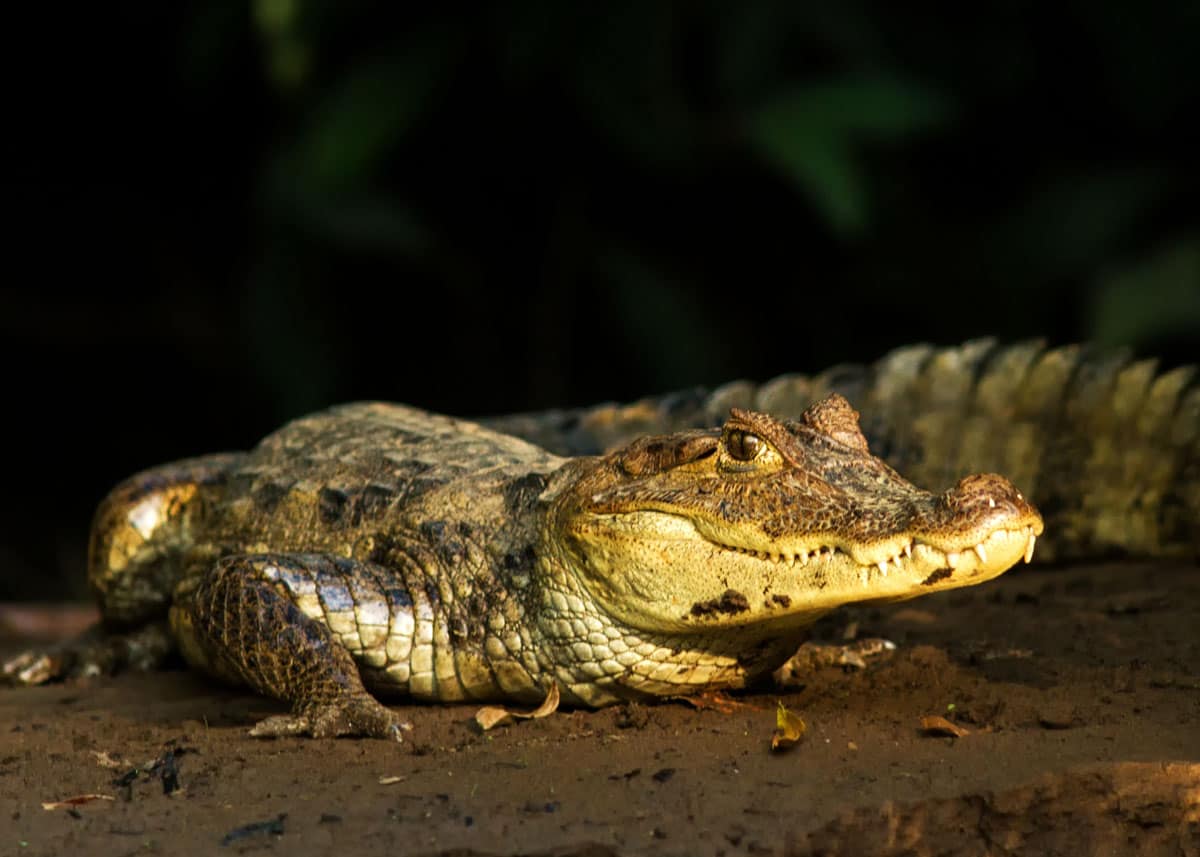
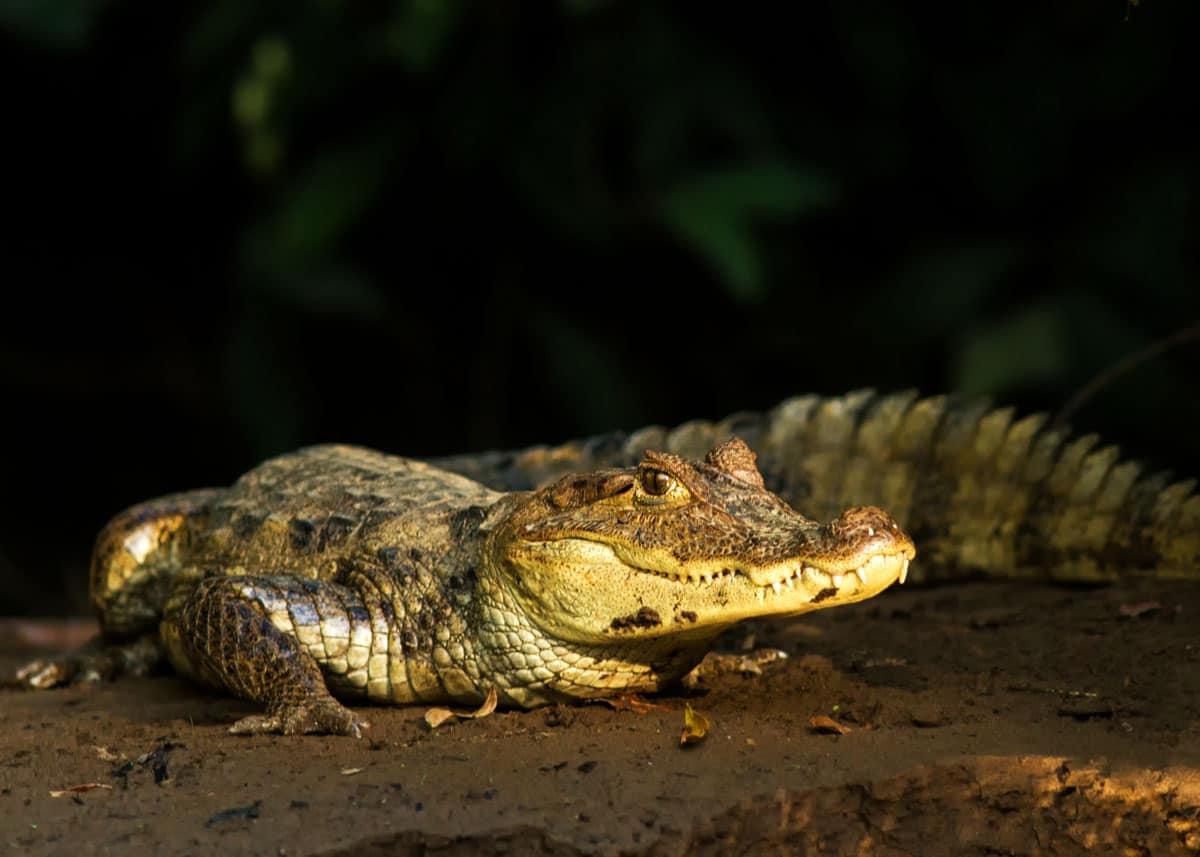
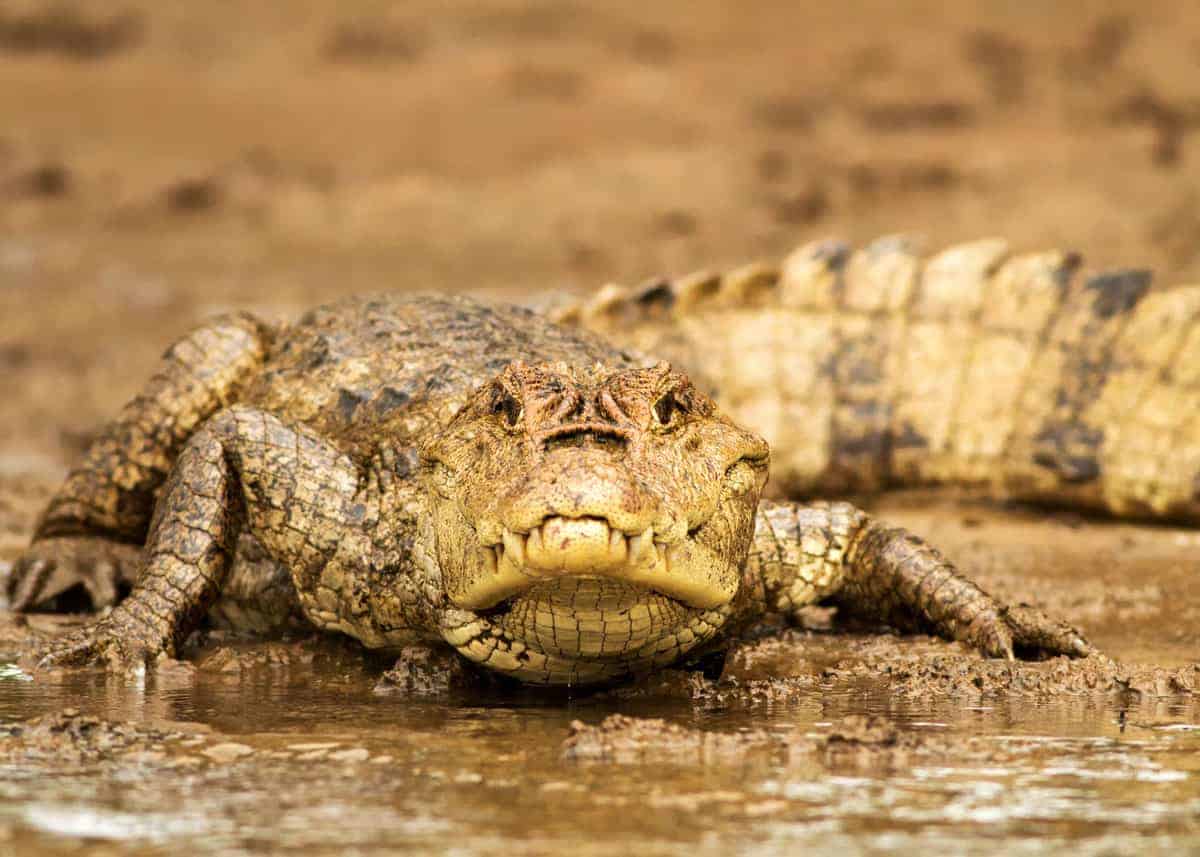
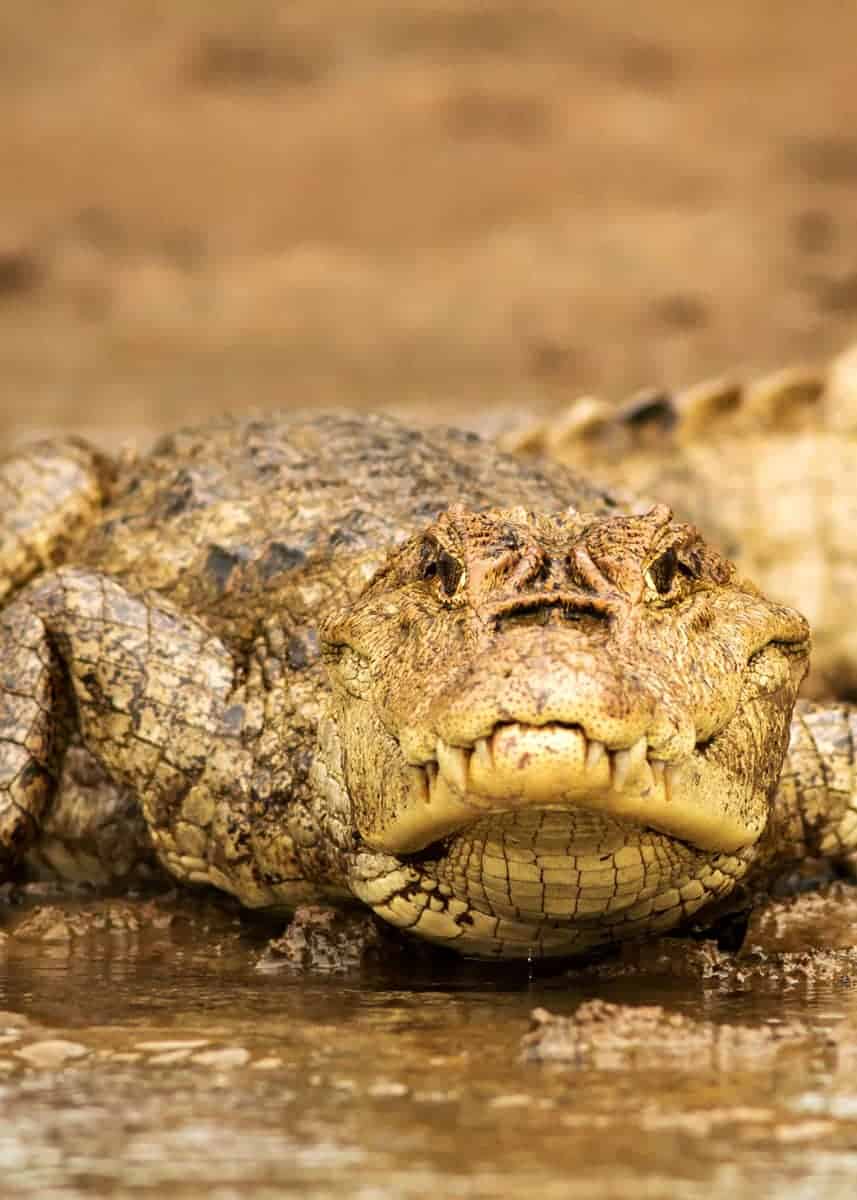
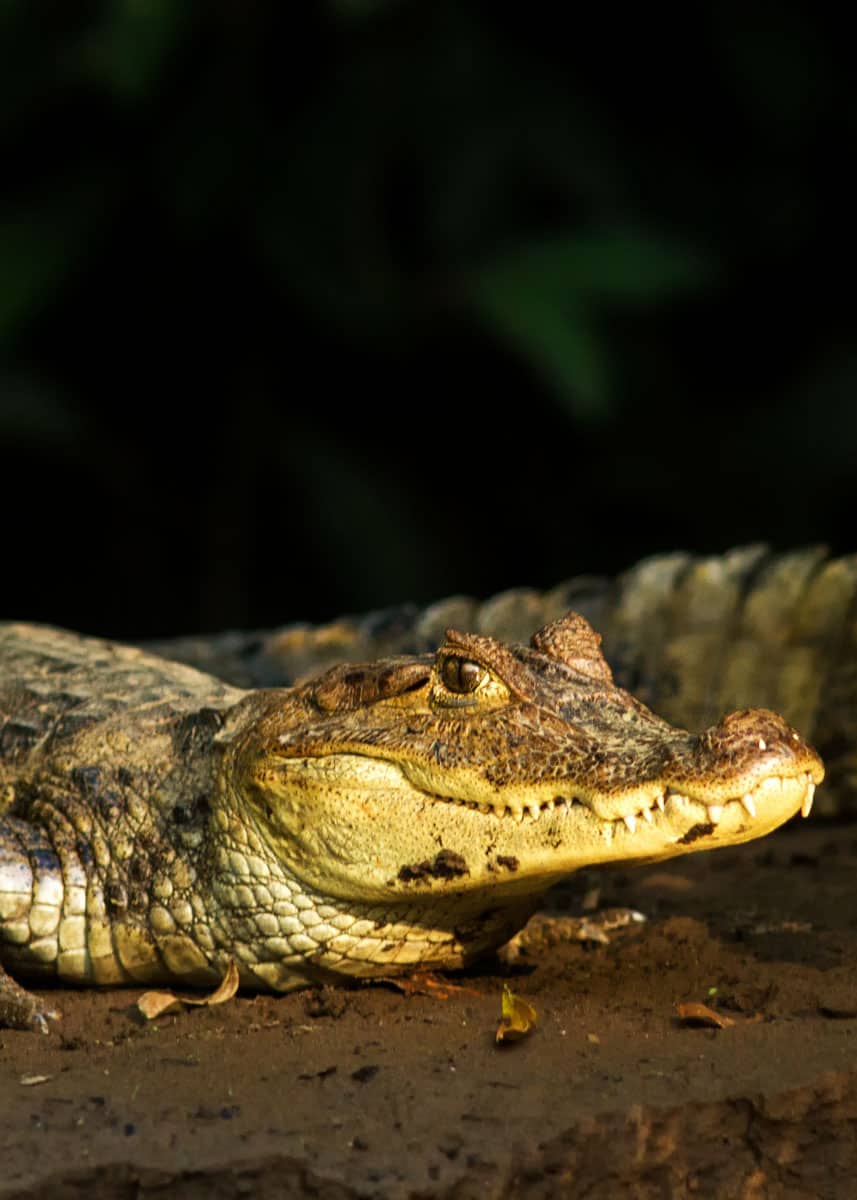






Very interesting and informative. Thanks.